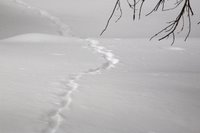
We have chosen for our last two visits to stay at the northeast corner of the park at Silver Gate, Montana. The Grizzly Lodge is less than a mile from the entrance to the park and about a 30 minute drive to the wolf viewing area between the Yellowstone Institute and Pebble Creek Campground. This area usually has an active wolf pack where wolves can be seen. To see the wolves, one must be at this location near sunrise. In other years there were wolf watchers there at sunset, we did not see that this year. We got up 3 of our 4 mornings to attempt to see the wolves and were successful twice. The middle morning, the pups were seen by folks near us, but the one dropped out of sight before I saw it.
However, where you look for the wolves changes every time we visit. The best way to see the wolves is to look for the group of people all standing together with scopes. This year the group was down in the valley looking up onto the northern grassy sage covered slopes. While my walking is better, I still have mobility issues and decided not to go down there. I set up my chair and scope on the side of the parking area where they were looking and waited.
Shortly, they turned their scopes a different direction. I rushed down to the other end of the parking lot and sure enough, there were the wolves, five of them. Using my Canon Powershot SX50 with its 1200 mm zoom I was able to capture these images. Most wolf sightings are distant, with the wolves appearing as small moving specks on the hillside.
Here is my first view of the wolf ascending the slope. The black wolves are easier to spot than the gray ones.
This shot captures two more . . .
I like the running shot.
Here it is cropped closer:

It is hard to explain the marvel that catching a glimpse of wolves in the wild invokes. For me part of the joy is that even when you get up to be there at sunrise, you may or may not get to see them. So when you do, it feels like such a blessing. In other visits I got to witness the morning reunion of the pack - such a joyful, playful event. I could hear the howls and yips.
Even when the wolves don't show, the upper Lamar Valley is a tranquil and beautiful place to spend the first hours of the day. It is a great way to start the day!










